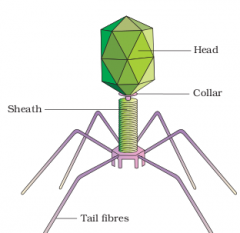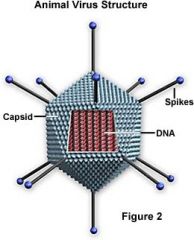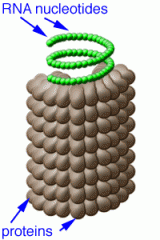![]()
![]()
![]()
Use LEFT and RIGHT arrow keys to navigate between flashcards;
Use UP and DOWN arrow keys to flip the card;
H to show hint;
A reads text to speech;
164 Cards in this Set
- Front
- Back
|
poison |
Virus means ___________ in latin. |
|
|
infectious |
A virus is an _________ particle |
|
|
Virion |
One virus particle is a _____________ |
|
|
1. very small |
Name 4 viral features which distinguish them from cells. |
|
|
20nm-300nm |
How small are viruses? |
|
|
4-200 genes |
How many genes does a virus have? |
|
|
1. ssDNA |
What are the 4 types of nucleic acid types found in viruses? |
|
|
obligate intracellular parasites |
A virus only grows within living cells so they are _______. |
|
|
host cell |
Viral proteins manufactured and nucleic acids replicated by the _______. |
|
|
False |
Viruses have ribosomes. (true/false) |
|
|
1. Make protein coat |
What is the minimum genetic information in a virus? |
|
|
1. Polyhedral |
What are the three shapes of viruses? |
|
|
Polyhedral |
a virus having many flat surfaces |
|
|
Helical |
A viral shape in which capsomeres are spiraled around a core. |
|
|
Complex |
a combination of both helical and polyhedral shape. |
|
|
the shape of its protein coat (capsid) |
What determines the shape of the virus? |
|
|
Envelope |
What is the membrane that surrounds the capsid of some viruses? |
|
|
Host cell plasma membrane |
Where does the virus acquire an envelope? |
|
|
Budding |
What method of exit from the host cell results in an envelope? |
|
|
1. In the nucleus |
Where do animal viruses replicate? |
|
|
adsorption |
The first step in infection is ______of the virus to the host cell. |
|
|
specific host cell receptors |
Where do viruses attach in the host? |
|
|
receptors |
The host cell is resistant if it lacks ________ to the virus. |
|
|
1. fusion |
What are the two methods of viral entry? |
|
|
envelopes |
Fusion occurs between the cytoplasmic membrane of the host with the virion ___________. |
|
|
endocytosis |
Both naked and enveloped virions enter by ________ |
|
|
Uncoating |
The separation of the viral nucleic acid and the capsid is called ________. |
|
|
replication |
More viral nucleic acid is made by __________ |
|
|
synthesis |
Capsid proteins are made by ___________. |
|
|
Maturation |
Self-assembly of viral component parts. |
|
|
1. Lysis of dead cells |
What are the two methods of viral release from a host cell? |
|
|
1. dsDNA integrates into the host cell genome |
How does a dsDNA virus become part of the host cell genome? |
|
|
Temin, Baltimore and |
The scientists that discovered reverse transcriptase. |
|
|
Host cell makes a DNA copy of the viral RNA using reverse transcriptase which is then integrated into the chromosome of the host cell. |
How do RNA retroviruses become part of the host cell genome? |
|
|
reverse transcriptase |
What is the enzyme encoded by retroviruses that allows for the conversion of RNA to DNA? |
|
|
Defence mechanisms |
In the case of animals, outcome of infection depends on many factors independent of the infected cell such as the ______ of the host. |
|
|
Balanced pathogenicity |
The infection of an animal in which the microbe causes no obvious harm or disease. |
|
|
Prions |
Proteinaceous infectious particles |
|
|
transmissible spongiform encephalopathies |
Prions cause _____________ |
|
|
Viriod |
Plant pathogens that are small ssRNA but no protein |
|
|
May be escaped introns |
Possible source of viriods. |
|
|
Complex Virus |

Virus morphology? |
|
|
Polyhedral (icosahedral) virus |

Virus morphology? |
|
|
Helical Virus |

Virus morphology? |
|
|
Scrapie |
Prion disesase seen in sheep and goats |
|
|
Kuru |
Prion disease seen in cannibals in New Guinea |
|
|
Bovine spongiform encephalopathy |
Mad cow disease |
|
|
1. Creutzfeldt-Jacob disease |
Name the prion diseases of humans |
|
|
PrPC |
The cellular prion protein |
|
|
PrPSc |
Scrapie protein |
|
|
Chronic Wasting Disease |
What is the prion disease of deer and elk? |
|
|
Kuru |
Which prion disease is also known as laughing disease? |
|
|
Transmissible mink encephalopathy |
What is the prion disease of Mink? |
|
|
Virus |
_____ is a genetic element that cannot replicate independently of a living (host) cell |
|
|
Virology |
____ is the study of viruses |
|
|
Viral infection |
A _______ occurs when a virus enters a host cell |
|
|
Conferring important properties. |
Not all viruses damage host cells. They may even be beneficial to the host by ______ |
|
|
1.Either DNA or RNA genomes |
Describe viral genomes. |
|
|
bacteriophages |
Bacterial viruses are called ___________ |
|
|
viridae |
Viral family names end in __________ |
|
|
smaller |
Most viruses are ____ (smaller/larger) than prokaryotic cells |
|
|
smaller |
Most viral genomes ____ (smaller/larger) than those of cells |
|
|
Capsid |
________ is the protein shell that surrounds the genome of a virus particle |
|
|
Capsomere |
_____ is a subunit of the capsid |
|
|
Nucleocapsid |
________ is a complete complex of nucleic acid and protein packaged in the virion |
|
|
Helical |
Rod-shaped viruses have _______ symmetry |
|
|
length of nucleic acid |
Length of virus determined by________ |
|
|
size and packaging of protein subunits |
Width of virus determined by _________ |
|
|
Icosahedral |
Spherical viruses have ______ symmetry |
|
|
20 |
Icosahedral viruses have _____ triangular faces |
|
|
Complex Viruses |
Virions composed of several parts, each with separate shapes and symmetries are _________ |
|
|
Icosahedral heads and helical tails |
Describe a typical bacterial virus |
|
|
Enveloped |
A ____ virus contains additional membrane layers around the nucleocapsid |
|
|
embedded proteins |
The viral envelope is a lipid bilayer with______ |
|
|
Enzymes for entry into host cell |
What are the three types of enzymes critical to infection? |
|
|
Neuraminidase |
Enzymes that cleave glycosidic bonds |
|
|
Lysozyme |
Enzyme that makes hole in cell wall of bacteria |
|
|
Bacterial |
___ viruses are easiest to grow and are used as model systems |
|
|
Plant |
_____ viruses are typically most difficult to grow because study often requires growth of whole host |
|
|
Titer |
___ is the number of infectious units per volume of fluid |
|
|
Plaque assay |
____ are analogous to the counting bacterial colonies; one way to measure virus infectivity |
|
|
Plaques |
___ are clear zones that develop on lawns of host cells |
|
|
Lawn |
___ is a continuous (confluent) growth of bacterial or tissue culture |
|
|
a single virus particle |
Each plaque results from infection by _____ |
|
|
Plaque-forming unit (PFU) |
____ is a measure of the number of virus particles capable of forming plaques per unit volume |
|
|
Infectious unit (IFU) |
____ is the smallest unit of virus that causes a detectable effect on a susceptible host |
|
|
Viral particles (VP) |
____ is the total number of viral particles, live and dead combined. |
|
|
lower |
The number of plaque-forming units is almost always ____ (lower/higher) than direct counts by electron microscopy |
|
|
Inactive virions |
Why are plague-forming units lower than direct counts |
|
|
ID50 |
The number of microbes to cause infection in 50% of test subjects. |
|
|
LD50 |
The number of microbes to cause death in 50% of test subjects. |
|
|
1 Attachment |
What are the phases of viral replication? |
|
|
Attachment |
____ is adsorption of the virus to a susceptible host cell |
|
|
Penetration |
______ is entry of the virion or its nucleic acid |
|
|
Synthesis |
_____ is the manufacturing of virus nucleic acid and protein by cell metabolism as redirected by virus |
|
|
Assembly |
____ is maturation of capsids and packaging of viral genomes into new virions |
|
|
Budding |
____ and ____ are the two methods of release of mature virions from the cell |
|
|
Endocytosis and fusion |
The two methods of entry of animal viruses into a host cell. |
|
|
Latent |
eclipse + maturation is the _____ period |
|
|
Enveloped |
Only _______ viruses can enter an animal cell by fusion. |
|
|
Eclipse |
____ is the period between adsorption of virus and the appearance of assembled virus progeny inside the cell |
|
|
Burst size |
______ is the number of virions released |
|
|
Class I |
Class ____ are double-stranded (ds) DNA viruses |
|
|
Class II |
Class ____ are single-stranded (ss) DNA viruses |
|
|
Class III |
Class ____ are dsRNA |
|
|
Class IV |
Class ____ are ssRNA + |
|
|
Class V |
Class ____ are ssRNA - |
|
|
Class VI |
Class ____ ssRNA + retroviruses. Use _______ enzyme |
|
|
Class VII |
Class ____ are dsDNA viruses that replicate through an RNA intermediate using _______ enzyme |
|
|
Attachment |
_____ requires complementary receptors on the surface of a susceptible host and its infecting virus |
|
|
carry out normal functions for cell (e.g., uptake proteins, cell to cell interaction) |
Receptors on host cell that the virus attaches to is used by the host to ________. |
|
|
penetration |
The attachment of a virus to its host cell results in changes to both virus and cell surface that facilitate ____. |
|
|
endocytosis |
Naked and enveloped viruses can enter by ____ |
|
|
fusion |
Only enveloped viruses may enter by ______ |
|
|
Uncoating |
___ is the process in which virions lose their outer coat and exposes the genome. |
|
|
Permissive cell |
____ is a host cell that allows the complete replication cycle of a virus to occur |
|
|
bacteriophage |
The type of virus that attaches to cells via tail fibers that interact with polysaccharides on the outer membrane of the host cell is a ____ |
|
|
immune defense mechanisms |
What are the eukaryotes mechanisms to diminish viral infections? |
|
|
CRISPR- Similar to RNA interference Restriction modification system |
What are the prokaryotes mechanisms to diminish viral infections? |
|
|
double-stranded DNA |
DNA destruction system of bacteria are only effective against _____viruses |
|
|
Restriction enzymes (restriction endonucleases) |
____ cleave DNA at specific sequences |
|
|
Chemical modification of viral DNA (glycosylation or methylation) |
How does a virus evade bacterial restriction systems? |
|
|
Baltimore |
____developed classification scheme for viruses based on relationship of viral genome to its mRNA |
|
|
retroviruses |
Baltimore, Temin, and Dulbecco discovered ____ and _____ |
|
|
plus (+) |
mRNA is said to be in ____ configuration |
|
|
genome |
Once a host has been infected, new copies of the viral _____ must be made and virus-specific ____ synthesized in order for the virus to replicate |
|
|
Positive |
____strand RNA virus: single-stranded RNA genome with same orientation as its mRNA |
|
|
Negative |
____ strand RNA virus: single-stranded RNA genome with orientation complementary to its mRNA |
|
|
1 synthesized soon after infection |
What are the characteristics of early proteins? |
|
|
1 Synthesized later Include proteins of virus coat |
What are the characteristics of late proteins? |
|
|
dsDNA |
Most phages contain ____ genomes |
|
|
lytic |
Temperate phages can also be ____ |
|
|
Early and middle proteins |
____ are enzymes needed for replication and transcription |
|
|
Late proteins |
_____ are head and tail proteins and enzymes required to liberate mature phage particles |
|
|
Lysogenic |
Temperate viruses can undergo a stable genetic relationship within the host. This is the _____ pathway |
|
|
Lysogeny |
____ is a state where most virus genes are not expressed and virus genome (prophage) is replicated in synchrony with host chromosome |
|
|
Lysogen |
___ is a bacterium containing a prophage |
|
|
lytic |
Viruses can enter a virulent mode in which it kills cells through____ pathway |
|
|
lytic |
Under certain conditions lysogenic viruses may revert to the ____ pathway and begin to produce virions |
|
|
Budding |
____ occurs as animal viruses leave host cell, they can remove part of host cell’s lipid bilayer for their envelope. |
|
|
Persistent |
During ____ infections, release of virions from host cell does not result in cell lysis |
|
|
Latent |
During ____ infections, there is a delay between infection by the virus and lytic events |
|
|
Transformation |
____ is the conversion of normal cell into tumor cell |
|
|
Cell fusion |
___ occurs when two or more cells become one cell with many nuclei |
|
|
Retroviruses |
____ are RNA viruses that replicate through a DNA intermediate |
|
|
two identical ssRNA molecules of the plus (+) orientation |
Retroviruses have a unique genome which consists of __________ |
|
|
1.Entrance into the cell |
What is the process of replication of a retrovirus? |
|
|
Defective |
_____ viruses that are parasitic on other viruses |
|
|
Defective |
_____ viruses require other virus (helper virus) to provide some function |
|
|
Satellite |
_______ viruses are defective viruses for which no intact version exists; rely on unrelated viruses as helpers |
|
|
Viroids |
____ are infectious RNA molecules that lack a protein coat |
|
|
plant |
Viriods cause a number of important ____ diseases |
|
|
Small, circular, ssRNA molecules |
Describe the genome of viriods. |
|
|
Prions |
____ are infectious proteins whose extracellular form contains no nucleic acid |
|
|
transmissible spongiform encephalopathies |
Prions cause disease in animals called ______ |
|
|
PrnP |
Host nerve cell contains gene ___ that encodes native form (PrPc) of prion protein that is found in healthy animals |
|
|
PrPc |
The native form of prion protein that is found in healthy animals is ______ |
|
|
PrPSc |
_____results form prion misfolding and causes neurological symptoms of disease (e.g., resistance to proteases, insolubility, and aggregation) |
|
|
1.Infectious prion disease |
What are the three distinct mechanisms of prion diseases? |
|
|
Infectious |
During _____ prion disease, a pathogenic form of prion protein is transmitted between animals or humans |
|
|
Sporadic |
During _____prion disease, random misfolding of a normal, healthy prion protein in an uninfected individual |
|
|
Inherited |
During _____ prion disease, a mutation in prion gene yields a protein that changes more often into disease-causing form |
|
|
Virulent |
During the _____ mode, viruses lyse host cells after infection |
|
|
Temperate |
During the ______mode, viruses replicate their genomes in tandem with host genome and without killing host |

